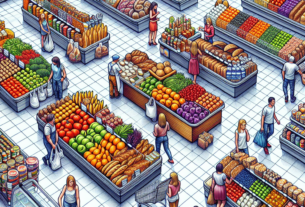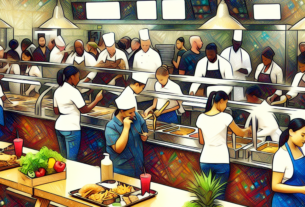Technology has revolutionized the way we live, work, and play. From smartphones to smart homes, it has become an integral part of our daily lives. One area where technology has made a significant impact is in the dining experience. In this report, we will explore how technology is enhancing the dining experience, from online reservations to contactless payments and everything in between.
The State of the Foodservice Industry in 2025
According to a report by CulinaryCoverage.com, the foodservice industry in 2025 is experiencing a wave of technological innovations that are reshaping the way restaurants operate and customers dine. With the rise of digital platforms and smart devices, restaurants are leveraging technology to streamline operations, enhance customer service, and increase efficiency.
Online Reservations and Ordering
One of the most significant ways technology is enhancing the dining experience is through online reservations and ordering systems. Gone are the days of waiting in long lines or calling ahead to secure a table at a restaurant. With the click of a button, customers can now make reservations online through platforms like OpenTable or Resy.
In addition to online reservations, many restaurants are also offering online ordering for takeout and delivery. This allows customers to browse menus, place orders, and pay online without ever having to pick up the phone. This convenience has become especially crucial in the wake of the COVID-19 pandemic, as more customers opt for contactless dining options.
Contactless Payments
Another way technology is enhancing the dining experience is through contactless payments. With the rise of mobile wallets and NFC technology, customers can now pay for their meals with a simple tap of their smartphone or smartwatch. This not only speeds up the payment process but also reduces physical contact between customers and restaurant staff.
Many restaurants are also implementing QR code menus and payment systems to further minimize contact. Customers can scan a QR code on their table to access the menu, place orders, and pay for their meals without ever having to interact with a physical menu or a server. This touchless dining experience has become increasingly popular among health-conscious consumers.
Personalized Recommendations
Technology is also enabling restaurants to provide personalized recommendations to customers based on their dining preferences and past orders. By leveraging data analytics and artificial intelligence, restaurants can analyze customer data to offer tailored suggestions for menu items, specials, and promotions. This not only enhances the customer experience but also increases customer loyalty and repeat business.
For example, a customer who frequently orders vegetarian dishes may receive personalized recommendations for new plant-based menu items or exclusive discounts on vegetarian meals. By catering to individual preferences, restaurants can create a more engaging and personalized dining experience for their customers.
Financial Impact of Technology in the Foodservice Industry
The adoption of technology in the foodservice industry has had a significant financial impact on restaurants. According to a study by Restaurant Business, restaurants that implement online ordering and delivery services see an average increase in sales of 20% to 30%. This growth can be attributed to the convenience and accessibility of online platforms, which attract new customers and encourage repeat business.
In addition to increased sales, technology also helps restaurants reduce operational costs and improve efficiency. For example, automated inventory management systems can help restaurants track inventory levels, reduce waste, and optimize ordering processes. This not only saves time and resources but also ensures that restaurants can meet customer demand and maintain profitability.
Furthermore, technology enables restaurants to gather valuable data on customer behavior, preferences, and trends. By analyzing this data, restaurants can make informed decisions about menu offerings, pricing strategies, and marketing campaigns. This data-driven approach can help restaurants stay competitive in a crowded market and adapt to changing consumer preferences.
Market Share and Competition
As technology continues to reshape the foodservice industry, competition among restaurants is becoming increasingly fierce. According to a report by Technomic, the top 500 restaurant chains in the United States saw a 3.6% increase in sales in 2024, driven by the adoption of technology and digital platforms. This growth highlights the importance of technology in gaining a competitive edge in the market.
In terms of market share, delivery and takeout services have seen significant growth in recent years, with companies like DoorDash, Uber Eats, and Grubhub dominating the market. These third-party delivery platforms have become essential for restaurants looking to reach a broader audience and increase sales. However, they also come with high fees and commission rates, which can eat into restaurant profits.
To compete in this landscape, many restaurants are investing in their own delivery services and online ordering platforms. By cutting out the middleman, restaurants can retain more of their profits and provide a seamless dining experience for customers. This direct-to-consumer approach allows restaurants to build stronger relationships with their customers and differentiate themselves from competitors.
Future Trends and Innovations
Looking ahead, the future of technology in the foodservice industry looks promising, with several trends and innovations on the horizon. One of the most anticipated developments is the rise of robotics and automation in restaurants. From robotic chefs to automated food preparation systems, technology is revolutionizing the way food is prepared, cooked, and served.
Another trend to watch is the integration of virtual reality and augmented reality into the dining experience. Imagine being able to explore a restaurant’s menu in 3D, visualize dishes before ordering, or even interact with virtual servers. These immersive technologies have the potential to enhance the dining experience and create unforgettable moments for customers.
Furthermore, the rise of smart kitchens and connected devices is also shaping the future of dining. Smart appliances, IoT sensors, and AI-powered kitchen assistants are making it easier for restaurants to monitor and control operations in real-time. This level of automation not only improves efficiency but also ensures consistency in food quality and service.
In conclusion, technology is transforming the dining experience in ways we never imagined. From online reservations to contactless payments, personalized recommendations, and beyond, restaurants are leveraging technology to enhance customer service, streamline operations, and drive growth. As we look to the future, the possibilities are endless, and the evolution of technology in the foodservice industry is sure to continue shaping the way we dine for years to come.



